
Fast tracking on the AC45
With Skandia Team GBR’s 49er squad being scaled back, so Chris Draper and Pete Greenhalgh have taken the opportunity to keep their bank managers happy by getting themselves recruited by AC teams.
With the first ever America’s Cup World Series regatta starting on 6 August, so Greenhalgh is in the unlikely position of sailing with the French aboard Energy Team with Loick Peyron/Yann Guichard (Greenhalgh and Peyron sailed together on the Extreme 40 Oman Sail Masirah last year) as Chris Draper, the Athens 49er bronze medallist and the2009 Extreme Sailing Series winning helmsman, has been announced as skipper of Team Korea.
Draper and Greenhalgh opted to investigate ‘other avenues’ following Sail for Gold, where they had failed to earn themselves the sole British 49er spot available for the Olympic test event.
“It was always a tricky decision to know whether to go back to the 49er or not,” admits Draper. “I went back to it after the Extreme 40 stuff and knowing what might happen with the AC, that there could be some opportunities there that I was potentially turning my back on - that has always been at the back of my mind. So the timing with Korea couldn’t really be better.”
CEO of Team Korea is Kim Dong-Young, well known, at least on the World Match Racing Tour, as the driving force behind the Korea Match Cup. So Draper did well to get the nod over the numerous match racing skippers who no doubt applied for the position. “I am over the moon,” he says. “I am very very pleased to be a part of it and as you can imagine, I am very proud to have been asked and keen to show that I can put it together.”
While a match racing skipper might be the more obvious choice for an America’s Cup team, this of course is not a normal America’s Cup: “At the end of the day with the way the AC World Series is working, you have to qualify for the match racing from the fleet racing, so the fleet racing carries quite a lot of weight,” says Draper. “Obviously further down the line with the Cup that changes...”
Compared to his new peers Draper admits he hasn’t done much match racing – he sailed a few events in the UK in 2006 and inadvertently did quite a lot in the two Oman Sail Extreme 40s when they used to train against one another over the winter months in Muscat. “But the match racing, as we know it, will be very different for this America’s Cup,” he says.
In addition to Draper, the Team Korea sailors are Kiwi Troy Tindill, who’s been a match racer and worked on various maxis, but most importantly this year has been boat captain of the ACRM AC45 (that has subsequently become Team Korea's) which he steered in ACRM’s test event in Auckland. The rest are Brits from powerhouse ex-Finn sailor Chris Brittle, to Olympic cat turned Extreme 40 sailor Mark Bulkeley to versatile bowman Matt Cornwell, a veteran of three AC campaigns, bowman on Ben Ainslie’s World Match Racing Tour crew and Rob Greenhalgh’s TeamOrigin Extreme 40 in 2008.
“I wanted to get a balance of people who were strong, people who had sailed the Extreme 40s and had sailed the AC45s and some people who brought some good match race assets,” says Draper of how he got the band together. “I spent a long time thinking about it and in the end we’ve tried to get on top of the boat handling as early as we could to give ourselves some tactical options, rather than having lots of tactical knowledge, but not being able to get the boat to do what we wanted it to do.”
They picked up Team Korea AC45 in Lisbon on 16 July. To date they have had seven days sailing it and will only have another seven prior to the start of the first AC World Series event in Cascais.
“We were quite lucky because our boat was the ACRM boat and it had been used in anger quite a bit,” states Draper. “That does mean that things like the rudder bearings are six months old, so there are a few areas where we are learning about the wear and are having to manage that a little bit. But the boat was pretty much ready to sail on day one. We went out and sailed it in 18-22 knots which was nerve wracking!”
So how have they been finding the transition from softsail Extreme 40 to wingsail AC45? Following their capsize last week, Draper says they have discovered the AC45 has runners... “Extreme 40s don’t have runners - that caught us out pretty badly the other day. The boat is a little bit narrower and the rig weight is quite a bit higher, so there seems to be a lot more potential to stick it over sideways than forwards.”
The principle handling different Draper says is that the bear away – typically the most dangerous moment on most racing multihulls - actually doesn’t seem to be that much of an issue on an AC45. As he puts it: “It is amazing how you can bear it away - it seems to like being born away with the hull up. On the first day Troy kept on trying to get me to lift the hull up for the bear away and I couldn’t get my head around it after three or four times of doing it – I’m pretty sure we would have capsized on every one on the Extreme 40...”
Equally Draper says that due to the heavier rig and the narrower beam when the AC45 starts to lift a hull it is a lot harder to bring it back down. “I would say they are twitchy, definitely! They are a good test. In comparison, the Extreme 40s are an absolute doddle to sail. On these there are not enough winches and it is like they have made the boat hard to sail on purpose.” In fact this is exactly what Russell Coutts envisaged for the AC45.
The capsize occurred when they came in on the port layline to do a tack bear away. “We came out of the tack onto the short sheet - because you have to load the kite onto the primary drum you are using for the jib,” explains Draper. “So everyone was in a rush to get ready to deploy the kite and as we bore away we realised that no one had let the leeward runner off and we just pulled it away, straight into it. So it was pretty embarrassing.”
But because it occurred in relatively benign conditions and flat water, and the RIB that was shadowing got in there in a matter of seconds, they came away complete unscathed. “We did manage to right it quickly – it almost seemed like there was the potential to water start it with the leeward wing sheet!” states Draper. “The RIB got in there really quickly, we wound in the leeward wing sheet on really hard and that kept the most of the water out of the wing. Then we were pulling it sideways, which emptied the little bit of water that had got into the front element in the mast wing spar, and then just towed it at 45 degrees upwind and up she popped.”
Once back on board they gingerly wound everything back in, found that all seemed to be okay and continued training. The incident may have gone completely unnoticed had it not been for someone spotting some unusual moisture in the wing when they came ashore...
While the wing was not damaged, it was a wake-up call for the crew and according to Draper they have reviewed the structure for their subsequent training and how much more it is fatiguing them than Extreme 40 sailing. Otherwise Draper is pleased with their progress so early on, although he acknowledges that they will up against opposition who have been training on AC45s for months now. “We hope to keep the learning curve going in the build- up to the event, but we are aware that we aren’t going to get on top of everything and we will have to start prioritising as we get closer.”
It seems likely that over the next few days Team Korea will end up doing some training with the French teams Aleph and Energy Team, who have a similar amount of experience in the AC45s.
As mentioned the AC45s are labour intensive and apart from steering, Draper says he has to tail and do some winching when Troy Tindell is trimming the wing, although not a huge amount. However he acknowledges that those mentioned represent the extent of their sailing squad, whereas other teams, including several others who are also in the early days of getting to grips with their new AC45s have pitched up in Lisbon in substantially larger numbers.
In terms of how sailing the AC45 differs from the Extreme 40, Draper confirms what other new wingsailors observe – that the wing is either well trimmed or it isn’t and there is substantially less ground in between than there is with a soft sail. That makes the trimming role vital. On the other hand the acceleration is second to none, says Draper. “It is amazing how late you can pull the trigger, especially with the reaching starts that we are doing, and be up to hull speed in such a short amount of time. But it also stops very very fast as well and if you sail into a lull you know about it quickly.”
Obviously in the last week we have learned of the demise of Venezia Challenge, although no great surprise... So will Team Korea go the distance? “I feel really confident that we will and that this team will build an AC72,” says Draper. “In term of the time line on that – our backs are against the wall, but that is all rolling on and fingers crossed it will get started in the time that it needs to. By the looks of things Team Korea will go with the design package [as in the standard package on off from ACRM - more here] and basically it is a case of managing the build and going from there. The big thing will be the wing and whether we can get a good build of that and a good design for that.”
Under the Deed of Gift for the America’s Cup, a challenger’s boat must be built in the country from where their challenge originates and while South Korea certainly has some world class composites expertise and manufacturing know-how, they don’t have any high-tech boat building specialists (for example until recently it was the world's largest ship builder).
“It is a case of getting all the structure there and having that in place in time - the team is working hard on that,” says Draper. “At the moment it is small and I think it is commendable that they have done nothing that they can’t achieve right now. I am very very confident that everything will take place as it needs to.”
Obviously Draper did two seasons with Oman Sail and there are parallels with Team Korea in as much as clearly a sell to the team’s sponsors will be eventually getting some Koreans into the otherwise Anglo-Saxon sailing team. However as a sailing nation Draper says that Korea is considerably more advanced than Oman. For example South Korea has sailors within the ISAF top 50 in both the Laser and the RS:X Men.
“At the moment we are under no illusion that the AC45 takes five people to sail it who are totally on their game, all of the time. That is not to say we couldn’t have green guys there quite quickly, but we are aware that the 72 will be the best opportunity for that,” states Draper.
In the meantime there is the no small matter of getting the Team Korea AC45 and its monster wing around the Cascais race track just 10 days from now...

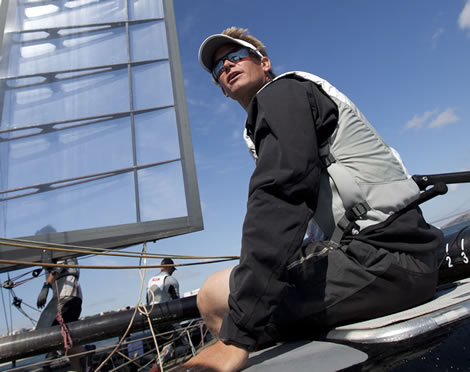
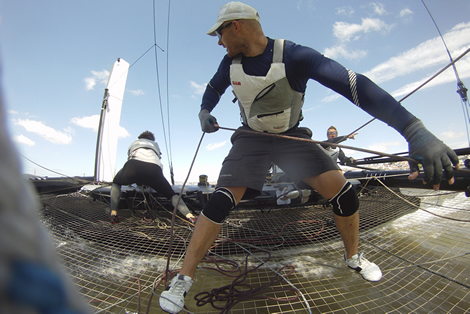
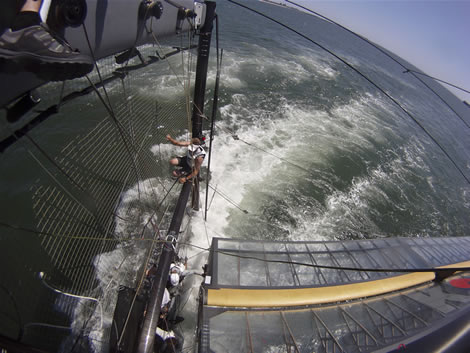
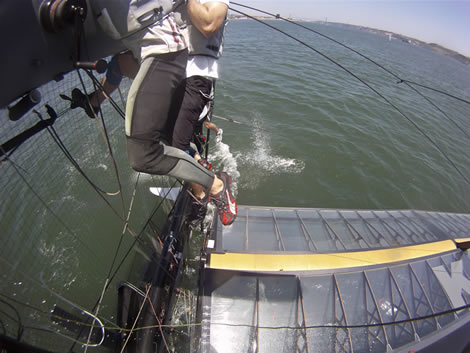
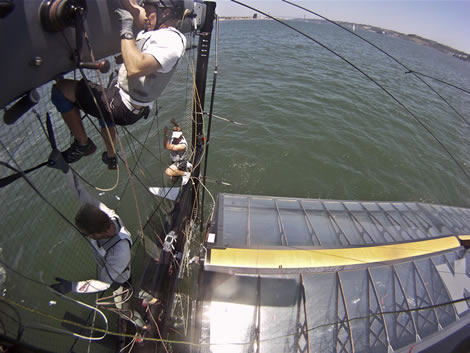







Latest Comments
Add a comment - Members log in